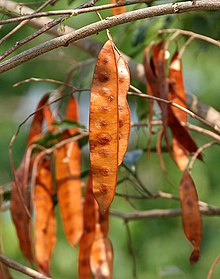| Albizia | |
|---|---|

| |
| Persian silk tree (Albizia julibrissin), foliage and blossoms | |
| Scientific classification | |
| Kingdom: | Plantae |
| Clade: | Tracheophytes |
| Clade: | Angiosperms |
| Clade: | Eudicots |
| Clade: | Rosids |
| Order: | Fabales |
| Family: | Fabaceae |
| Subfamily: | Caesalpinioideae |
| Clade: | Mimosoid clade |
| Genus: | Albizia Durazz. (1772) |
| Diversity | |
| About 150 species | |
| Synonyms[1] | |
| |

Albizia is a genus of more than 160 species of mostly fast-growing subtropical and tropical trees and shrubs in the subfamily Mimosoideae of the family Fabaceae. The genus is pantropical, occurring in Asia, Africa, Madagascar, America and Australia, but mostly in the Old World tropics. In some locations, some species are considered weeds.
They are commonly called silk plants, silk trees, or sirises. The obsolete spelling of the generic name – with double 'z' – is still common, so the plants may be called albizzias. The generic name honors the Italian nobleman Filippo degli Albizzi, who introduced Albizia julibrissin to Europe in the mid-18th century.[2] Some species are commonly called mimosa, which more accurately refers to plants of genus Mimosa. Species from southeast Asia used for timber are sometime termed East Indian walnut.
- ^ Albizia Durazz. Plants of the World Online. Retrieved 4 August 2023.
- ^ Cite error: The named reference
pawas invoked but never defined (see the help page).